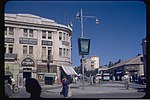Ben Yehuda Street (Jerusalem)
Car-free zones in the Middle EastDowntown Triangle (Jerusalem)Pedestrian mallsStreets in JerusalemTourist attractions in Jerusalem ... and 1 more
Year of establishment missing

Ben Yehuda Street (Hebrew: רחוב בן יהודה), known as the "Midrachov" (Hebrew: מדרחוב), is arguably the most famous street in Jerusalem, along with Jaffa Road. Ben Yehuda Street joins with Jaffa Road and King George Street in the heart of downtown Jerusalem to form the main Downtown Triangle central business district. Closed to vehicular traffic, the street is now Jerusalem's most popular pedestrian mall. The street runs from the intersection of King George Street east to Zion Square and Jaffa Road. The street is named after the founder of Modern Hebrew, Eliezer Ben-Yehuda.
Excerpt from the Wikipedia article Ben Yehuda Street (Jerusalem) (License: CC BY-SA 3.0, Authors, Images).Ben Yehuda Street (Jerusalem)
Mordechai Ben Hilel, Jerusalem Nahalat Shiva
Geographical coordinates (GPS) Address Nearby Places Show on map
Geographical coordinates (GPS)
| Latitude | Longitude |
|---|---|
| N 31.7815 ° | E 35.2176 ° |
Address
מרדכי בן הלל
Mordechai Ben Hilel
9423005 Jerusalem, Nahalat Shiva
Jerusalem District, Israel
Open on Google Maps







